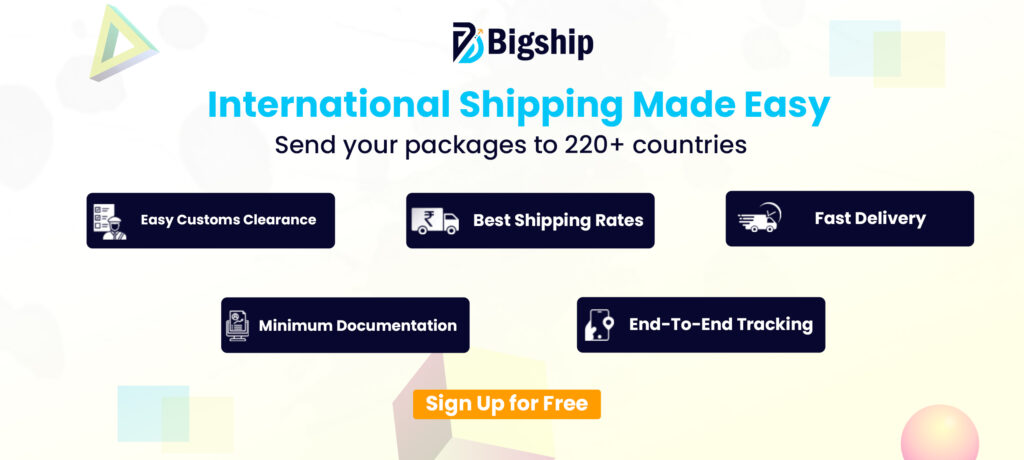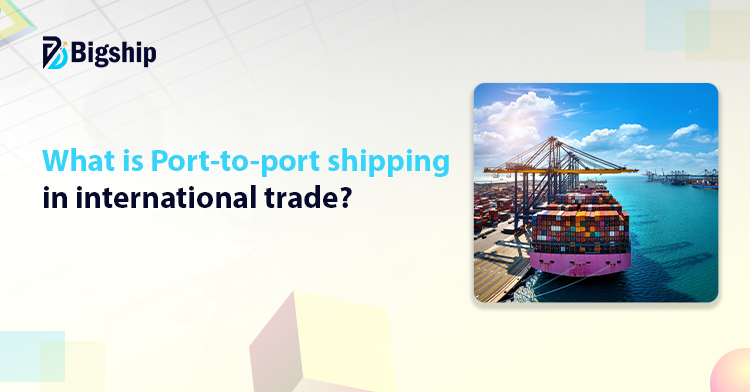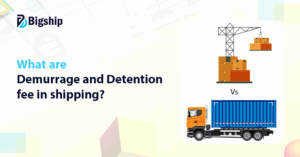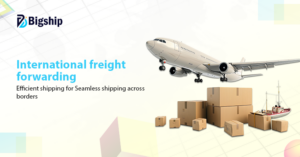Port-to-port shipping is the sea journey between two ports and is the core leg of international trade. It’s where goods are loaded at one dock and reach another, ready for port delivery. Many exporters and importers prefer it because it gives control, saves costs, and keeps the process straightforward.
In India, the ports are busier than ever. Between April and January 2024 alone, major ports handled around 677.22 million tonnes of cargo. The cumulative of merchandise exports during April-June 2025 was USD 112.17 billion. But amid this large-scale movement, one question often comes up what does port to port mean?

So, in this blog, we will explore everything about port-to-port shipping.
What is the Meaning of Port-to-Port Shipping?
In simple words, port-to-port shipping means moving goods from one seaport to another. This won’t include pickup from the warehouse or delivery to the buyer’s doorstep. Just the sea journey between two ports.
The port-to-port meaning focuses only on the ocean leg of transport where the goods are loaded onto the ship at the port of origin and unloaded at the port of destination. Everything before and after that like trucking, storage, or customs, stays in your hands.
In port-to-port shipping, the shipper ensures the cargo reaches the loading port and once it arrives at the destination port, the buyer takes over. Businesses often choose this method when they already manage inland logistics. It helps them stay in control of land operations and costs.
This approach is common for both FCL (Full Container Load) and LCL (Less than Container Load) shipments. In port shipping, you pay the shipping line for the sea transport only and then take charge of everything else yourself.
How port-to-port shipping process work?
The process of port-to-port shipping follows a clear set of steps. And each of these steps plays an important role in moving goods from one port to another.
Preparation of cargo: The cargo is packed, labeled, and made export-ready. You ensure the goods meet all shipping and safety rules. Proper preparation avoids delays later and this step sets the base for a safe port shipping journey.
Sending to port of loading: Once the cargo is ready, it moves to the port of loading through trucks or trailers. At the port, the goods are checked, weighed, and kept in a storage area until the vessel is ready to take them on board.
Loading and departure of cargo: Next comes the process of loading. For this large cranes are used that lift the containers and place them carefully on the ship. Once loading is done, the ship departs for its sea route.
Cargo in transit: This phase of port-to-port shipping is the ocean journey. The ship carries the containers across international waters.
Arrival at the port of destination: When the vessel reaches the destination, unloading begins. The containers are moved from the ship to the port area. Customs officers check the paperwork and clear the goods for port delivery.
Receiving cargo: This is the final stage where the consignee or their agent collects the goods from the destination port.
Advantages of Port-to-Port Shipping
Every business looks for smarter ways to move goods. Port-to-port shipping often turns out to be that smart move. Here’s why many companies prefer it over full-service options.
Cost-effective choice: In port-to-port shipping, you only pay for the ocean leg and nothing beyond that. There are no middlemen or any extra inland charges and this alone cuts a big slice off your total transport cost. Many companies already have their own ground logistics, so paying again for door pickup or delivery makes little sense. In port-to-port shipping, you save money and still get your cargo across the sea.
More control over the journey: In port-to-shipping, you decide who handles your shipment at both ports. You pick the trucker, the warehouse, and even the clearing agent. That means you stay in charge, not the shipping line. Also, in case of sudden delays or changes occur, you can act faster because the process runs on your terms and that kind of control is a huge plus in logistics.
Flexibility in operations: Every business has its own way of handling goods and port-to-port shipping gives space to adjust those operations freely. You can partner with your preferred local agents, switch routes, or even change schedules if needed.
Ideal for bulk or frequent shipments: This method suits companies shipping in large volumes or on regular schedules. Since the process repeats in a fixed pattern, i.e., load, sail, unload, it fits perfectly for industries like automotive, retail, and manufacturing.
Transparent and easy-to-track: You stay closer to the process when you handle parts of it yourself. Tracking updates, port clearances, and schedules stay visible to you. This transparency gives confidence as you always know where your shipment stands and when it will arrive.
Services typically included in port-to-port shipping
Port-to-port shipping might sound limited, but it still includes a few essential services that make the sea journey possible. The services that are provided in port shipping include:
- The first and most obvious part is space on the vessel. When you book port shipping, you get a confirmed spot on the vessel. It could be for a full container if you have enough cargo, or a shared section if it’s a smaller load.
- Shipping without paperwork is impossible. So, part of this service includes essential documents like the Bill of Lading, sea waybill, and cargo manifest.
- Port freight handling is also included as part of the core service in port shipping. Once your goods reach the port, cranes and dock equipment take charge. The same happens in reverse when they reach the destination port.
- Many carriers keep you informed while the vessel is at sea. You receive updates on the ship’s location, expected arrival, and any possible delay.
Key considerations in port-to-port shipping
Port-to-port shipping gives you freedom and control, but it also comes with a few things you must plan carefully. Let’s go through the key points that deserve your attention.
Planning inland movement: You must arrange transport to take the goods from your location to the port of loading and later from the destination port to the final address. It can be trucks, trains, or both.
Keeping an eye on port timings: Ports have fixed working hours, sailing schedules, and holidays. So, before sending your shipment for port shipping, check the port’s timing and cut-off dates. Missing them can mean paying heavy demurrage or storage fees.
Handling customs procedures: Under port-to-port shipping, customs clearance is your responsibility. You’ll need to file export documents at the loading port and import papers at the destination.
Protecting cargo through insurance: Ocean transport has its risks such as rough weather, water damage, or container loss. A proper cargo insurance keeps you safe if things go wrong mid-sea. Hence, it’s better to pay a little extra than lose everything to an accident at sea.
Coordinating agents and partners: Having trusted agents at both ends can save you a lot of stress. They handle customs, coordinate with port authorities, and update you about the cargo’s status. Reliable partners make sure your goods are shipped out immediately following arrival.
How Bigship simplifies port-to-port shipping for businesses?
Bigship makes port-to-port shipping easier and convenient. You don’t have to juggle multiple agents or chase updates. Bigship connects you directly with trusted carriers for smooth port freight movement. The process is simple, you book the shipment, and then Bigship handles the coordination between ports. Every step, from cargo loading to port delivery, stays transparent through real-time tracking and instant notifications.
The platform gives you competitive freight rates, multiple carrier choices, and a clear view of your shipment’s journey. You stay in control without dealing with confusing paperwork or hidden charges. Bigship also ensures your documents, schedules, and shipment details are handled correctly so you avoid last-minute issues at ports.
Key Takeaways
- Port-to-port shipping covers only the sea leg of the journey, from the loading port to the destination port.
- Cargo moves directly between ports.
- Proper documentation and customs clearance at both ends are essential.
- This method is cost-effective since you pay only for port freight, not door-to-door services.
- It suits businesses with large shipments or frequent export-import operations.
Conclusion
Port-to-port shipping keeps international trade simple and focused. It cuts down unnecessary costs and gives you control over your cargo from one port to another. By managing inland transport, customs, and documentation yourself, you can ensure timely port delivery and reduce risks along the way. For businesses moving large or frequent shipments, it’s a practical and efficient way to handle sea freight.
Bigship makes this process even easier as it connects you with trusted carriers, provides clear tracking, and ensures smooth handling at both ends. With Bigship, port-to-port shipping becomes reliable, transparent, and hassle-free.
So sign up with Bigship and ensure safe and timely movement of your cargo.
FAQs
What does port to port mean in shipping?
Port-to-port means the shipment moves only between two seaports, i.e., from the port of origin to the port of destination.
Who is responsible for cargo before and after the sea journey?
The shipper handles delivery to the origin port, and the consignee manages collection from the destination port.
Can port-to-port shipping handle both FCL and LCL shipments?
Yes, both full container load (FCL) and less than container load (LCL) are supported under port-to-port shipping.





